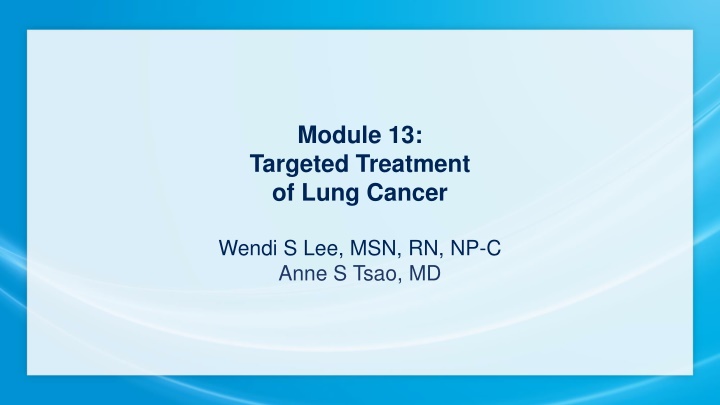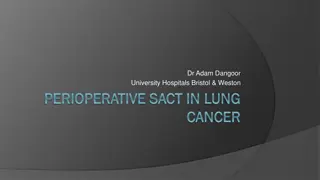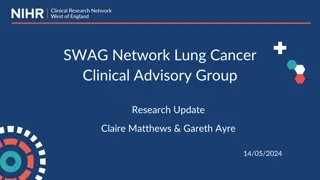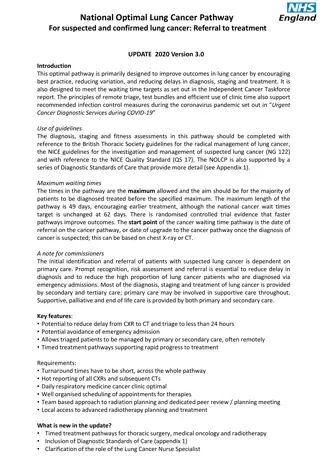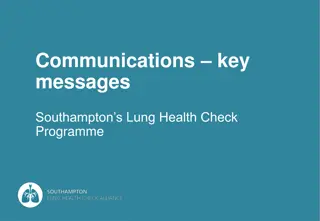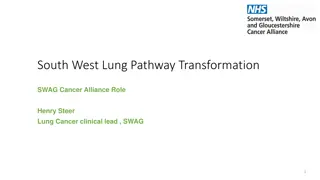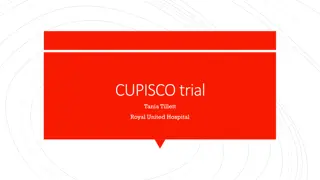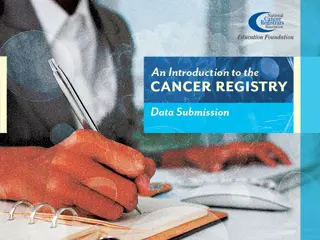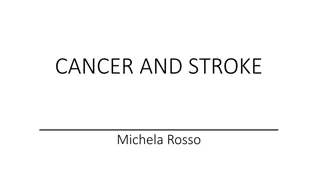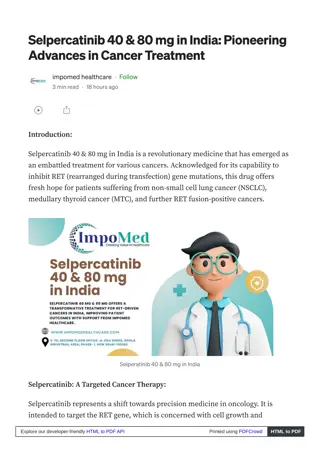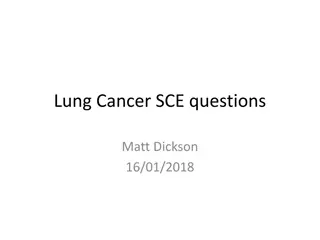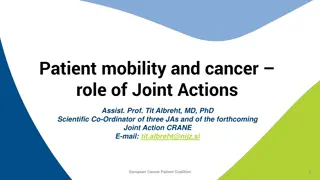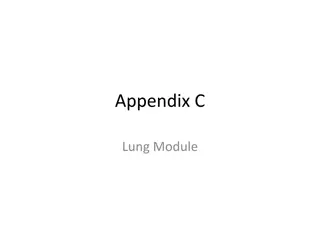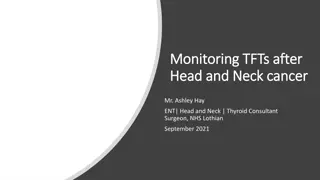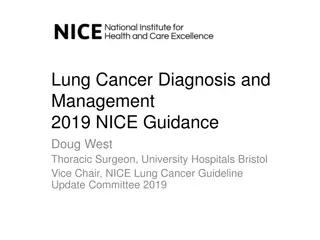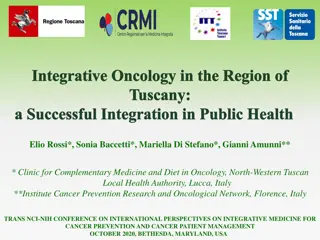Targeted Treatment Options for Lung Cancer Patients
Explore targeted treatment approaches for lung cancer through real-life patient cases, expert insights, and updates on therapies. Learn about personalized care, innovative options, and advancements in non-small cell lung cancer treatment. Delve into disclosures from healthcare professionals involved in lung cancer management. Discover the impact of targeted therapies in improving outcomes and quality of life for patients.
Download Presentation

Please find below an Image/Link to download the presentation.
The content on the website is provided AS IS for your information and personal use only. It may not be sold, licensed, or shared on other websites without obtaining consent from the author.If you encounter any issues during the download, it is possible that the publisher has removed the file from their server.
You are allowed to download the files provided on this website for personal or commercial use, subject to the condition that they are used lawfully. All files are the property of their respective owners.
The content on the website is provided AS IS for your information and personal use only. It may not be sold, licensed, or shared on other websites without obtaining consent from the author.
E N D
Presentation Transcript
Module 13: Targeted Treatment of Lung Cancer Wendi S Lee, MSN, RN, NP-C Anne S Tsao, MD
Disclosure for Ms Lee Consulting Agreement Pfizer Inc
Disclosures for Dr Tsao Disclosures for Dr Tsao Ariad Pharmaceuticals Inc, AstraZeneca Pharmaceuticals LP, Boehringer Ingelheim Pharmaceuticals Inc, Bristol- Myers Squibb Company, EMD Serono Inc, Genentech, Huron, Lilly, Merck, Novartis, Roche Laboratories Inc, Seattle Genetics, SELLAS Life Sciences, Takeda Oncology Advisory Committee Ariad Pharmaceuticals Inc, Boehringer Ingelheim Pharmaceuticals Inc, Bristol-Myers Squibb Company, Epizyme, Genentech, Lilly, Merck, Polaris Group, Seattle Genetics, Takeda Oncology Contracted Research Data and Safety Monitoring Board/Committee Xcovery
Approximately how many patients with the following types of cancer have you interacted with over the past year? Type of cancer Breast cancer Lung cancer Colorectal cancer Myelodysplastic syndromes Multiple myeloma Chronic lymphocytic leukemia Pancreatic cancer Diffuse large B-cell lymphoma Prostate cancer Follicular lymphoma Melanoma Median 40 35 30 20 20 15 10 10 10 7 6 Type of cancer Ovarian cancer Median 6 Renal cell carcinoma 6 Hepatocellular carcinoma 5 Gastric cancer 5 Acute myeloid leukemia 4 Hodgkin lymphoma 4 Urothelial bladder cancer 4 Endometrial cancer 3 Cervical cancer 2 Mantle cell lymphoma 2
Day in the Life: Targeted Treatment of Lung Cancer 81 F, osimertinib, mild rash, issues with elderly husband s health 78 F, osimertinib, Dx with brain mets in 2016, refused radiation or aggressive chemo but started osimertinib recent scans showing decreased size of brain mets and stable lung nodule 84 F, TKI, rash 75 F, afatinib, very unusual neurologic symptoms of unknown origin despite multiple MRIs/CTs looking for brain mets, progressing bone mets
Updates on Targeted Therapies in NSCLC Anne S. Tsao, M.D. Professor Section Chief, Thoracic Medical Oncology Director, Mesothelioma Program Director, Thoracic Chemo-XRT Program November 2019 The University of Texas The University of Texas Department of Thoracic/Head & Neck Medical Oncology MD ANDERSON MD ANDERSON CANCER CENTER CANCER CENTER
Outline: Targeted Therapy Updates Molecular Profiling Cell-free DNA (plasma testing) Background Common and Rare Mutations Toxicities EGFR Agents Toxicities ALK/ROS1 Other mutations RET, BRAF, MET exon 14, NTRK Agents Toxicities
Molecular Testing per IASLC-ACP-AMP Gene mutation testing (panels or NGS), PD-L1 IHC, ALK IHC, FISH Tumor Tissue Circulating cell-free tumor DNA (cfDNA) Blood Urine ACP-IASLC-AMP 3 categories of Biomarkers: 1) Must-test (standard of care) 2) Should-test (direct to clinical trials) 3) Investigational and not for clinical use at this time Experimental and Not Validated Sputum
Frontline Histology and Molecular Profiling October 2019 NSCLC PATIENT PD-L1 IHC (-) or < 50% Any histology but no actionable mutation PD-L1 IHC (+) > 50% SCC > 50% PD-L1 Platinum- Pemetrexed- Pembrolizumab Non-SCC Pembrolizumab No actionable Mutations and PD-L1 < 50% Platinum-taxane- pembrolizumab, IMpower131 MET exon 14 skip mutation Rare mutations: Afatinib Adenocarcinoma Avoid pemetrexed or bevacizumab, or necitumumab + cis/gem EGFR exon 20: Poziotinib, TAK-788 Crizotinib, Tepotinib (trial) Savolitinib (trial) EGFR RET ROS1 BRAF V600E EML 4 ALK Common mutations: Osimertinib, Dacomitinib, Erlotinib, Gefitinib, Afatinib Cabozantinib, Vandetanib LOXO-292 (trial) BLU-667 (trial) Dabrafenib+ Trametinib Crizotinib, Ceritinib, Entrectinib, Lorlatinib NTRK Crizotinib, Alectinib, Ceritinib Brigatinib HER2 Platinum-pemetrexed-pembrolizumab Platinum-paclitaxel-bevacizumab-atezolizumab (IMpower150) Platinum-doublet + bevacizumab Non-platinum or platinum based doublet If T790M and prior 1st or 2nd gen EGFR TKI, Osimertinib Entrectinib Larotrectinib Ceritinib, Alectinib, Brigatinib, Lorlatinib (breakthrough designation only) Ado-trastuzumab Exon 20: poziotinib (trial)
FLAURA: Survival Soria J-C et al. N Engl J Med 2018;378:113-125
EGFR TKI Toxicity 1st generation TKIs Rash Diarrhea No concomitant H2 blocker use Fatigue Abnormal liver function Nail and eyelash changes 3rd generation TKI QTc prolongation (check EKG, echo), decreased heart function Electrolyte abnormalities Rash (mild) Abnormal liver function Diarrhea 2nd generation TKIs Rash (more) Diarrhea (more) Fatigue Mouth ulcers Abnormal liver or kidney function Nail or eye irritation
70 y/o Female with Metastatic Lung Adenocarcinoma with Activating EGFR Mutation 70 y/o woman from Colorado who presented to her physician in November 2018 with mild left hip pain CT revealed a large sclerotic bony lesion in the left ilium and acetabulum PET/CT on November 1, 2018 revealed a left upper lobe lung mass, hypermetabolic mediastinal and left hilar lymph nodes, diffuse hypermetabolic activity within the left iliac bone with associated sclerosis, a hypermetabolic sclerotic lesion in the left anterior third rib, and a hypermetabolic lesion in the right humerus Biopsy of the left iliac bone mass revealed metastatic adenocarcinoma consistent with a lung primary. Molecular testing revealed an activating EGFR mutation (exon 21 L858R).
70 y/o Female with Metastatic Lung Adenocarcinoma with Activating EGFR Mutation First visit in our clinic was in January 2019 Shortly after she started frontline therapy with Osimertinib on a phase 2 clinical trial that allows local consolidation therapy after initial Osimertinib April 15, 2019 PET/CT showed that the left upper lobe tumor, mediastinal and hilar lymph nodes, and bony lesions were no longer hypermetabolic. MRI of the brain was negative for intracranial disease She subsequently underwent left upper lobectomy followed by post operative radiation therapy to the left upper lobe and hilum and SBRT to the right upper lobe lesion Imaging continues to show response with stability of bony disease and no new lesions This patient has had minimal side effects from Osimertinib
70 y/o Female with Metastatic Lung Adenocarcinoma with Activating EGFR Mutation January 2019 January 2019 before Osimertinib before Osimertinib April 2019 after April 2019 after 2.5 months of Osimertinib 2.5 months of Osimertinib
Patient Education When Initiating Osimertinib Explain reason for choosing Osimertinib as therapy (this medication Explain reason for choosing Osimertinib as therapy (this medication targets the mutation found in your tumor cells) targets the mutation found in your tumor cells) Discuss barriers to receiving medication (insurance approval, prior auth, Discuss barriers to receiving medication (insurance approval, prior auth, specialty pharmacy, home delivery, etc.) specialty pharmacy, home delivery, etc.) Osimertinib may be taken with or without food at the same time every Osimertinib may be taken with or without food at the same time every day day Recommend discontinuation of herbal supplements prior to initiating Recommend discontinuation of herbal supplements prior to initiating Osimertinib Osimertinib Explain follow up, monitoring, and restaging schedule Explain follow up, monitoring, and restaging schedule
Osimertinib: Potential Toxicities/Side Effects Osimertinib: Potential Toxicities/Side Effects and Management and Management Skin (acneiform skin rash trunk, face, scalp, extremities; dry skin) Management: Initiate emollients at start of therapy, use OTC steroid and antihistamine cream as needed, then escalate to prescription strength topical steroid/antibiotic or oral if necessary, steroid shampoos for scalp irritation, USE SUN SCREEN/PROTECTION Nails (nail changes, irritation around nail beds, paronychia) Management: emollients, white vinegar soaks, steroid/antibiotic creams, oral antibiotics if needed, open toe shoes, use gloves, refer to podiatry/dermatology if no resolution Diarrhea Management: Loperamide, prescription meds if needed, hold drug Fatigue Management: Encourage rest as needed and exercise as tolerated Anorexia Management: Encourage frequent meals/snacks
Osimertinib: Potential Toxicities/Side Effects Uncommon Uncommon Toxicities/Side Effects Toxicities/Side Effects - Mouth ulcers - Cytopenias (white cells, red cells, platelets) Potential Serious Adverse Events (Rare) Potential Serious Adverse Events (Rare) - Pneumonitis/Interstitial lung disease - QTC prolongation (baseline EKG, f/u EKG as needed/per provider preference) - Cardiomyopathy (baseline Echo and f/u Echo as needed/per provider preference) - Keratitis
Updates on Targeted Therapies in NSCLC Anne S. Tsao, M.D. Professor Section Chief, Thoracic Medical Oncology Director, Mesothelioma Program Director, Thoracic Chemo-XRT Program November 2019 The University of Texas The University of Texas Department of Thoracic/Head & Neck Medical Oncology MD ANDERSON MD ANDERSON CANCER CENTER CANCER CENTER
Frontline Histology and Molecular Profiling October 2019 NSCLC PATIENT PD-L1 IHC (-) or < 50% Any histology but no actionable mutation PD-L1 IHC (+) > 50% SCC > 50% PD-L1 Platinum- Pemetrexed- Pembrolizumab Non-SCC Pembrolizumab No actionable Mutations and PD-L1 < 50% Platinum-taxane- pembrolizumab, IMpower131 MET exon 14 skip mutation Rare mutations: Afatinib Adenocarcinoma Avoid pemetrexed or bevacizumab, or necitumumab + cis/gem EGFR exon 20: Poziotinib, TAK-788 Crizotinib, Tepotinib (trial) Savolitinib (trial) EGFR RET ROS1 BRAF V600E EML 4 ALK Common mutations: Osimertinib, Dacomitinib, Erlotinib, Gefitinib, Afatinib Cabozantinib, Vandetanib LOXO-292 (trial) BLU-667 (trial) Dabrafenib+ Trametinib Crizotinib, Ceritinib, Entrectinib, Lorlatinib NTRK Crizotinib, Alectinib, Ceritinib Brigatinib HER2 Platinum-pemetrexed-pembrolizumab Platinum-paclitaxel-bevacizumab-atezolizumab (IMpower150) Platinum-doublet + bevacizumab Non-platinum or platinum based doublet If T790M and prior 1st or 2nd gen EGFR TKI, Osimertinib Entrectinib Larotrectinib Ceritinib, Alectinib, Brigatinib, Lorlatinib (breakthrough designation only) Ado-trastuzumab Exon 20: poziotinib (trial)
ALEX Study Design ENDPOINTS Primary PFS (RECIST 1.1), by investigator review KEY ELIGIBILITY ALK+ by central IHC testing Advanced or metastatic ALK+ NSCLC Treatment-na ve ECOG PS 0 2 Measurable disease Asymptomatic brain metastases allowed Alectinib 600 mg BID PO R A N D O M I Z E Secondary PFS by IRC Time to CNS progression ORR, DOR OS Safety and tolerability Patient-reported outcomes NO CROSSOVER Crizotinib 250 mg BID PO Stratification factors: ECOG PS (0/1 vs 2) Race (Asian vs non-Asian) Brain metastases (present vs absent) ALK, anaplastic lymphoma kinase; IHC, immunohistochemistry; NSCLC, non-small-cell lung cancer; ECOG PS, Eastern Cooperative Oncology Group Performance Status; PO, by mouth; PFS, progression-free survival; IRC, independent review committee; CNS, central nervous system; ORR, objective response rate; DOR, duration of response; OS, overall survival Peters et al. NEJM 377: 829-838, Aug 2017
ALEX Survival Peters et al. NEJM 377: 829-838, Aug 2017
ALEX CNS Activity Agent CNS Activity Crizotinib Limited Alectinib Yes Ceritinib Yes Brigatinib Yes CNS objective response rate* Lorlatinib Yes Ensartinib Yes Measurable and non-measurable CNS lesions at baseline Measurable CNS lesions at baseline Crizotinib (N=58) Alectinib (N=64) Crizotinib (N=22) Alectinib (N=21) CNS responders, n (%) 11 (50) 17 (81) CNS responders, n (%) 15 (26) 38 (59) (95% CI) (15 39) (46 72) (95% CI) (28 72) (58 95) CNS complete response, n (%) 5 (9) 29 (45) CNS complete response, n (%) 1 (5) 8 (38) Median DOR in the CNS, months 3.7 NE Median DOR in the CNS, months 5.5 17.3 (95% CI) (3.2 6.8) (17.3 NE) (95% CI) (2.1 17.3) (14.8 NE) Peters et al. NEJM 377: 829-838, Aug 2017 *IRC assessment Presented by: Alice T. Shaw
Lorlatinib in Treatment-Nave ALK+ Patients Solomon BJ, et al. WCLC 2017 abstr#8573
Toxicity Comparison of Selected ALK Inhibitors Agent Toxicities Crizotinib Vision Transaminitis Nausea, diarrhea Peripheral edema Ceritinib Abdominal pain Nausea Diarrhea Transaminitis Alectinib Myalgia LFT elevation Brigatinib Pulmonary toxicity Lorlatinib Hypercholesterolemia CNS (delirium, MS changes)
43 y/o Woman with Metastatic Lung Adenocarcinoma with ALK Rearrangement 43 y/o woman who presented in 2014 with hemoptysis. She was found to have a right 43 y/o woman who presented in 2014 with hemoptysis. She was found to have a right upper lobe mass with extensive adenopathy. upper lobe mass with extensive adenopathy. Right upper lobe biopsy on August 25, 2014 revealed adenocarcinoma. Molecular Right upper lobe biopsy on August 25, 2014 revealed adenocarcinoma. Molecular profiling was later performed, revealing ALK gene rearrangement. profiling was later performed, revealing ALK gene rearrangement. She received concurrent chemoradiation with weekly carboplatin and paclitaxel for She received concurrent chemoradiation with weekly carboplatin and paclitaxel for locally advanced (stage IIIB) lung cancer. Combined therapy was complete in locally advanced (stage IIIB) lung cancer. Combined therapy was complete in November 2014. She received two cycles of consolidation chemotherapy with November 2014. She received two cycles of consolidation chemotherapy with carboplatin and pemetrexed. carboplatin and pemetrexed. Restaging PET/CT in February 2015 revealed disease progression with new bone and Restaging PET/CT in February 2015 revealed disease progression with new bone and liver lesions. liver lesions. Crizotinib was initiated as frontline therapy for stage IV disease with ALK Crizotinib was initiated as frontline therapy for stage IV disease with ALK rearrangement. rearrangement.
43 y/o Woman with Metastatic Lung Adenocarcinoma with ALK Rearrangement February 2015 before February 2015 before treatment with treatment with Crizotinib Crizotinib April 2015 after 8 weeks April 2015 after 8 weeks on Crizotinib on Crizotinib Toxicities Experienced with Crizotinib: Fatigue, nausea, anorexia Toxicities Experienced with Crizotinib: Fatigue, nausea, anorexia managed symptomatically, but ultimately required dose reduction symptomatically, but ultimately required dose reduction managed
43 y/o Woman with Metastatic Lung Adenocarcinoma with ALK Rearrangement In July 2016, she had disease progression in the liver and started second line therapy with Ceritinib In July 2016, she had disease progression in the liver and started second line therapy with Ceritinib November 2016 after 4 months of November 2016 after 4 months of Ceritinib Ceritinib July 2016 prior to Ceritinib July 2016 prior to Ceritinib Toxicities Experienced with Ceritinib: Nausea and Diarrhea Toxicities Experienced with Ceritinib: Nausea and Diarrhea - - Managed symptomatically, but ultimately required dose reduction Managed symptomatically, but ultimately required dose reduction
43 y/o Woman with Metastatic Lung Adenocarcinoma with ALK Rearrangement In December 2017, she had progression in the liver and initiated third line therapy with Alectinib In December 2017, she had progression in the liver and initiated third line therapy with Alectinib December 2017 before December 2017 before Alectinib Alectinib February 2018 after 2 months of February 2018 after 2 months of Alectinib Alectinib Toxicities Experienced with Alectinib: None significant, she actually experienced Toxicities Experienced with Alectinib: None significant, she actually experienced weight gain weight gain
43 y/o Woman with Metastatic Lung Adenocarcinoma with ALK Rearrangement July 2019 July 2019 disease progression in the liver disease progression in the liver New liquid biopsy was performed to evaluate for new alterations or New liquid biopsy was performed to evaluate for new alterations or mechanisms of resistance (no new actionable alterations were identified) mechanisms of resistance (no new actionable alterations were identified) August 2019 August 2019 initiated 4 initiated 4th th line therapy with Lorlatinib line therapy with Lorlatinib 10/2019 10/2019 PET/CT revealed resolution of the two new liver lesions, no new PET/CT revealed resolution of the two new liver lesions, no new disease disease Toxicities Experienced with Lorlatinib: Lower extremity edema (managed Toxicities Experienced with Lorlatinib: Lower extremity edema (managed with intermittent diuretics), hyperlipidemia (managed with rosuvastatin), with intermittent diuretics), hyperlipidemia (managed with rosuvastatin), mild cognitive changes (no interventions/close monitoring for worsening) mild cognitive changes (no interventions/close monitoring for worsening)
Patient Education when initiating ALK TKIs Explain reason for choosing this medication as first line, second, third, etc., therapy (this medication targets the mutation found in your tumor cells) Discuss barriers to receiving medication (insurance approval, prior auth, specialty pharmacy, home delivery, etc.) Explain how to take medication - With or without food?, swallow whole, take at the same time every day Avoid grapefruit/grapefruit juice Photosensitivity dermatitis is rare, but wearing sunscreen is recommended Recommend discontinuation of herbal supplements prior to initiating an ALK inhibitor Explain follow up, monitoring, and restaging schedule
ALK TKIs: Potential Toxicity/Side Effects and Management Common Toxicities/Management: Common Toxicities/Management: GI Toxicities GI Toxicities (nausea/vomiting, diarrhea, abdominal pain/cramping) - Management: supportive meds (anti-emetics, anti-diarrheal, pain meds), hold drug, dose reduction Elevated Hepatic Enzymes Elevated Hepatic Enzymes - - Management: monitor closely, higher grade - follow manufacturer guidelines for holding and dose reduction Fatigue Fatigue Management: encourage rest and exercise, for severe fatigue consider holding drug or dose reduction Peripheral Edema Peripheral Edema Management: encourage feet elevation, ambulation, exercise, for severe edema can consider diuretics Vision Changes Vision Changes Management: ophthalmology consult, low threshold for holding drug, dose reduction Weight Loss Weight Loss Management: encourage increase caloric intake (frequent snacks), dietician consult, consider appetite stimulants Myalgias Myalgias Management: for severe hold drug and restart when grade one or less (may require dose reduction), monitor CK/CPK, pain meds if needed Less Common Potentially Severe Toxicities: Less Common Potentially Severe Toxicities: Bradycardia, QT Prolongation Bradycardia, QT Prolongation Interstitial Lung Disease Interstitial Lung Disease Hepatic Toxicity Hepatic Toxicity
ALK TKIs Specific Toxicities Crizotinib: Crizotinib: Visual disturbances, vision loss Ceritinib Ceritinib: : GI toxicity (nausea/vomiting, abdominal cramping, diarrhea), hyperglycemia, pancreatitis Alectinib: Alectinib: Muscle cramping, elevated CK, anemia Brigatinib: Brigatinib: Respiratory toxicity (dyspnea/cough), increased risk of ILD in first week of treatment, HTN, hyperglycemia, headache, pancreatitis Lorlatinib: Lorlatinib: High cholesterol, cognitive changes, weight gain
Intracranial Disease in Patients with ALK Rearrangement Intracranial disease Intracranial disease ALK positive patients can develop intracranial disease. Oncology nurses can help their providers remember to routinely image the brain in this patient population. Ceritinib, Alectinib, Brigatinib and Lorlatinib have CNS penetration and intracranial disease can be treated systemically with these agents potentially avoiding further radiation. Our patient described here had intracranial disease as described below Our patient described here had intracranial disease as described below 12/2015 PD in brain with at least 20 lesions, completed Whole Brain Radiation in 12/2015 6/2018 Stereotactic Radiosurgery for two enlarging intracranial lesions 7/2019 MRI showed stable to slightly more prominent subcentimeter enhancing lesions with 2 questionable new punctate foci. No new intervention to date.
43 y/o Woman with Metastatic Lung Adenocarcinoma with ALK Rearrangement
Appalachian Mountains in Appalachian Mountains in Kentucky Kentucky
Updates on Targeted Therapies in NSCLC Anne S. Tsao, M.D. Professor Section Chief, Thoracic Medical Oncology Director, Mesothelioma Program Director, Thoracic Chemo-XRT Program November 2019 The University of Texas The University of Texas Department of Thoracic/Head & Neck Medical Oncology MD ANDERSON MD ANDERSON CANCER CENTER CANCER CENTER
ROS1 Rearrangements in NSCLC Present in ~1% of NSCLC cases (also found in some glioblastomas, gastric, ovarian, cholangiocarcinomas) TPM3-ROS1 SDC4-ROS1 Enriched in younger never or light smokers with adenocarcinoma histology SLC34A2-ROS1 No overlap with other oncogenic drivers CD74-ROS1 First-line agents: crizotinib, ceritinib, entrectinib EZR-ROS1 Not FDA approved: lorlatinib LRIG3-ROS1 ROS1 Bergethon et al., JCO 30(8): 863-70, 2012; Takeuchi et al., Nat Med 18(3): 378-81, 2012
Entrectinib biology and pharmacology ROS1 pathway Extracellular matrix Entrectinib is an oral, potent and selective ROS1/NTRK/ALK tyrosine kinase inhibitor that is CNS active ROS1 TRKB TRKC ALK TRKA Cell More potent ROS1 inhibitor than crizotinib in preclinical studies membrane Fusion Partner TRK N O N Potent pan-TRK inhibitor in multiple tumor histologies Inhibition of downstream pathways (MAPK PI3K/AKT) F Cytoplasm O F Entrectinib is FDA approved for ROS1 NSCLC Entrectinib Inhibition of TRK phosphorylation Cell cycle arrest and apoptosis Inhibition of cell proliferation In-vitro/in-vivo tumor growth inhibition Rolfo, et al. Expert Opin Investig Drugs 2015; Ahn, et al. WCLC 201
Frontline Histology and Molecular Profiling October 2019 NSCLC PATIENT PD-L1 IHC (-) or < 50% Any histology but no actionable mutation PD-L1 IHC (+) > 50% SCC > 50% PD-L1 Platinum- Pemetrexed- Pembrolizumab Non-SCC Pembrolizumab No actionable Mutations and PD-L1 < 50% Platinum-taxane- pembrolizumab, IMpower131 MET exon 14 skip mutation Rare mutations: Afatinib Adenocarcinoma Avoid pemetrexed or bevacizumab, or necitumumab + cis/gem EGFR exon 20: Poziotinib, TAK-788 Crizotinib, Tepotinib (trial) Savolitinib (trial) EGFR RET ROS1 BRAF V600E EML 4 ALK Common mutations: Osimertinib, Dacomitinib, Erlotinib, Gefitinib, Afatinib Cabozantinib, Vandetanib LOXO-292 (trial) BLU-667 (trial) Dabrafenib+ Trametinib Crizotinib, Ceritinib, Entrectinib Lorlatinib NTRK Crizotinib, Alectinib, Ceritinib Brigatinib HER2 Platinum-pemetrexed-pembrolizumab Platinum-paclitaxel-bevacizumab-atezolizumab (IMpower150) Platinum-doublet + bevacizumab Non-platinum or platinum based doublet If T790M and prior 1st or 2nd gen EGFR TKI, Osimertinib Entrectinib Larotrectinib Ceritinib, Alectinib, Brigatinib, Lorlatinib (breakthrough designation only) Ado-trastuzumab Exon 20: poziotinib (trial)
NTRK NTRK TRK receptor family involves TrkA, TrkB, TrkC encoded by NTRK1,2,3. Involved in neuronal development Gene rearrangements confer oncogenic properties to the TRK receptors NTRK fusions in 0.1%-2.4% NSCLC, former or current smokers NTRK1,2,3 mutations are mutually exclusive Phase 1 Basket trials 3 responses (one NSCLC) Larotrectinib highly selective inhibitor Basket trial 3/4 responses in NSCLC Farago AF et al, J Thorac Oncol 10:1670, 2015; Ricciuti B et al, Med Oncol 34:105, 2017; Okamura K et al, Lung Cancer 78:100-6, 2012; Khotskaya YB, et al: Pharmacology and Therapeutiecs 173:58-99, 2017; Drilon et al, Cancer Discov 7(4):400-409, 2017; Farago et al, WCLC, 2018; Drilon A et al: NEJM #&*:731, 2018
NTRK Inhibitors NTRK Inhibitors Entrectinib CHF (median time to onset 2 months) Cognitive impairment, dizziness Mood disorders Sleep disturbance Abnormal liver function labs Hyperuricemia QTc prolongation Visual changes Fatigue Edema Diarrhea Nausea Myalgia Larotrectinib Fatigue Pyrexia Peripheral edema Nausea/vomiting Diarrhea Abnormal liver function labs Anemia CNS toxicity (delerium, encephalopathy)
BRAF Mutations in NSCLC Serine-threonine kinase of RAF family downstream of KRAS; activates MAPK BRAF mutations originally described in melanoma but also seen in colon, thyroid, lung cancers and other solid tumors Lung adenocarcinomas 1-5% with 50% having V600E mutation; other mutations G469A, D594G Patient characteristics V600E female, light/never smoker Non V600E smokers Prognostic significance unclear Reports of slow disease progression and long-term survival Rothschild: Cancers 7:930, 2015; Tissot: Lung Cancer 91:3, 2016; Myall: Clin Lung Ca 17:e17, 2016; Caparica: Crit Rev Oncol/Hem 101:32, 2016
Mechanism of Action for Dual MAPK Pathway Inhibition With Dabrafenib + Trametinib RTKs P Dabrafenib mechanism of action Reversible, small molecule BRAF inhibitor ATP competitive BRAF V600E: IC50 0.65 nM SOS Grb2 SHC P P P P P Dabrafenib RAS PI3K/AKT/mTOR pathway BRAF V600 BRAF CRAF Trametinib mechanism of action Reversible, small molecule MEK1 and MEK2 allosteric inhibitor MEK1 and MEK2: IC50 0.7 and 0.9 nM MEK Trametinib ERK1/2 p90RSK MSK1 Proliferation, Growth, Survival Davies H, et al. Nature. 2002;417:949-954; Platz A, et al. Mol Oncol. 2008;1:395-405; Karasarides M, et al. Oncogene. 2004;23:6292-6298; Long, et al. N Engl J Med. 2014;371:1877; Gilmartin AG, et al. Clin Cancer Res. 2011;17:989-1000.
Dabrafenib and Trametinib V600E Treatment Naive RR 64%, 2 CR Med DOR 10.4 mo Med PFS 10.9 mo Med OS 24.6 mo Planchard D, et al. Lancet Oncol. 18:1307-16, 2017
Frontline Histology and Molecular Profiling October 2019 NSCLC PATIENT PD-L1 IHC (-) or < 50% Any histology but no actionable mutation PD-L1 IHC (+) > 50% SCC > 50% PD-L1 Platinum- Pemetrexed- Pembrolizumab Non-SCC Pembrolizumab No actionable Mutations and PD-L1 < 50% Platinum-taxane- pembrolizumab, IMpower131 MET exon 14 skip mutation Rare mutations: Afatinib Adenocarcinoma Avoid pemetrexed or bevacizumab, or necitumumab + cis/gem EGFR exon 20: Poziotinib, TAK-788 Crizotinib, Tepotinib (trial) Savolitinib (trial) EGFR RET ROS1 BRAF V600E EML 4 ALK Common mutations: Osimertinib, Dacomitinib, Erlotinib, Gefitinib, Afatinib Cabozantinib, Vandetanib LOXO-292 (trial) BLU-667 (trial) Dabrafenib+ Trametinib Crizotinib, Ceritinib, Entrectinib, Lorlatinib NTRK Crizotinib, Alectinib, Ceritinib Brigatinib HER2 Platinum-pemetrexed-pembrolizumab Platinum-paclitaxel-bevacizumab-atezolizumab (IMpower150) Platinum-doublet + bevacizumab Non-platinum or platinum based doublet If T790M and prior 1st or 2nd gen EGFR TKI, Osimertinib Entrectinib Larotrectinib Ceritinib, Alectinib, Brigatinib, Lorlatinib (breakthrough designation only) Ado-trastuzumab Exon 20: poziotinib (trial)
RET Fusions in NSCLC Intact tyrosine kinase domain fused to an upstream gene partner most common: KIF5B others: CCDC6, NCOA4, TRIM33, KIAA1468 Ligand-independent dimerization and downstream growth pathway activation Oncogenic in vitro and in vivo 1-2% NSCLC; younger; never/light smokers; adenocarcinoma/poorly differentiated Drilon AD, Cancer Discov 2013;3:630-5, Kohno T, Nat Med 2012;18:375-7, Saito M, Carcinogenesis 2014;35:2452-6;Suehara Y, Nat Med 2012;18;6599-608, Lipson D, Nat Med 2012;18:382-40, Takeuchi K, Nat Med 2012;18:378-81
Efficacy of LOXO-292 (selpercatinib) in RET fusion-positive NSCLC FDA breakthrough designation RET fusion-positive NSCLC 4 0 K IF5B -R E T Enrolled 38 C C D C 6-R E T 2 0 Eligible for response evaluation 38 C LIP 1-R E T 26/38 68% R E T R earrangem ent N O S Overall Response Rate (95% CI) Best Tum or Response (% ) 0 (51% - 83%) 25/37 68% Confirmed ORR* -2 0 (50% - 82%) CR - PR** 26 -4 0 SD 8 PD 2 -6 0 NE 2 -8 0 4/4 confirmed intracranial responses (1 CR, 3 PR) in patients with measurable (> 5 mm) intracranial lesions -1 0 0 Prior Chemo Prior IO Prior M KI Prior other therapy Toxicities Fatigue, Diarrhea, Constipation, Dry mouth, Nausea, Dyspnea pending confirmation; * Excludes one patient with unconfirmed PR pending confirmation at time of data cut-off; ** 25 confirmed PR, 1 unconfirmed PR pending confirmation Follow-up as of July 19, 2018. Oxnard et al, WCLC 2018
Special Issues in Oncology Care Management of current smokers; vaping
